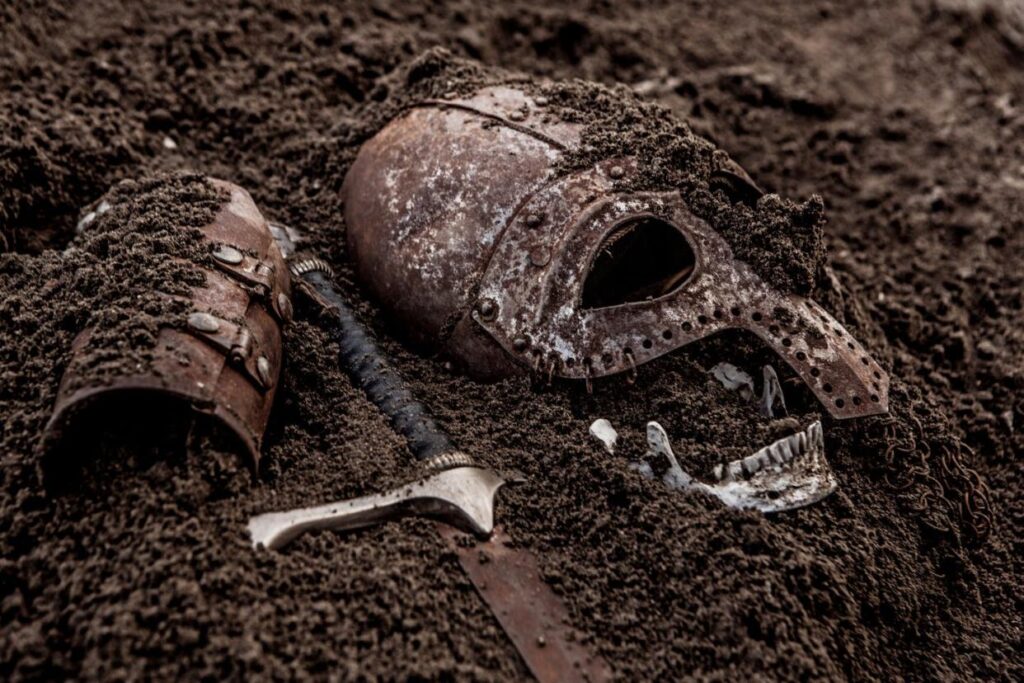Archaeological discoveries often begin with the mundane, sometimes involving nothing more than a hunch or a small anomaly in the landscape. For one team of archaeologists working on a farm in Scandinavia, what started as an ordinary excavation to investigate what they thought were buried wires ended in an extraordinary discovery: a cache of Viking treasure. The mistaken identity of the find points to a broader narrative within the field of archaeology—one that involves rethinking assumptions, encountering surprises, and, ultimately, rewriting history.
The Setup: An Ordinary Excavation
The setting was a rural farm somewhere in Denmark—a region that has long been known for its rich archaeological deposits. For centuries, the soil of this land has safeguarded remnants of the past, from the Stone Age to the Viking Age. Local farmers, well aware of the area’s history, had reported finding peculiar artifacts from time to time: a bronze brooch here, a piece of pottery there. But this particular excavation began with a rather unremarkable objective: to investigate what appeared to be an underground system of wires. The initial assumption was that these wires were remnants of modern infrastructure, perhaps an old telecommunications or power line long since decommissioned.
Using ground-penetrating radar (GPR), the archaeologists detected a series of linear shapes beneath the soil. To the untrained eye, they looked like wires or cables, prompting the team to hypothesize that they were dealing with a relatively recent installation. The excavation team was prepared for an exercise in documentation rather than discovery—until they began digging.
The Unveiling: A Discovery Beyond Expectation
As shovels pierced the earth and the team carefully removed layers of soil, something unexpected began to emerge. Instead of the expected modern materials—plastic insulation, copper, or steel—they encountered objects gleaming faintly in the sunlight. What they had assumed were wires turned out to be strands of silver and gold, twisted and intertwined in a manner characteristic of Viking craftsmanship.
These strands weren’t part of any electrical system; they were jewelry—bracelets, necklaces, and rings—each intricately woven and richly adorned. The team immediately halted their excavation to reassess the situation, realizing they were in the midst of an unreported Viking hoard. The dig, which began as a routine task, quickly transformed into a scene of intense academic interest. The site, now a potential treasure trove, demanded a new approach, one that respected the cultural and historical significance of the objects they were unearthing.
Contextualizing the Find: Viking Treasures and Their Significance
The Viking Age, spanning roughly from 793 to 1066 AD, was a period of vast cultural and economic expansion for Scandinavian societies. While they are often remembered as marauding raiders, the Vikings were also master craftsmen, shrewd traders, and skilled navigators. Their influence extended from the shores of North America to the river valleys of Russia, and their material culture reflected a confluence of local tradition and external influence.
The discovery of a hoard like the one at the farm is not without precedent, but it is always significant. Viking hoards often served multiple purposes. They could be an emergency stash, a ritual deposit, or a form of wealth display. In some cases, such treasures were hidden during times of conflict or upheaval, left by their owners with the intention of retrieving them later—intentions that were, for one reason or another, never fulfilled.
What made this particular find unique was the context of its misidentification. Modern archaeological tools, such as GPR, are designed to detect objects below the surface, but interpreting these signals can be challenging. The strands of precious metal initially appeared similar to the linear signatures of buried wires, and it was only through physical excavation that their true nature was revealed. This misstep underscores a broader issue in archaeology: the reliance on technology must be balanced with careful, on-site observation and interpretation.
The Artifacts: Examining the Viking Craftsmanship
Upon closer examination, the objects unearthed displayed a level of artistry that spoke to the sophistication of Viking metalworking. The gold and silver wires, some as thin as a human hair, had been braided and twisted into complex patterns. These were not just adornments; they were symbols of power, status, and identity.
The hoard included torcs, a type of rigid neck ring often associated with Celtic and Germanic tribes but adopted and adapted by the Vikings. Some pieces bore inscriptions in runic script, while others were decorated with zoomorphic designs—stylized depictions of animals such as serpents and wolves, which held symbolic significance in Norse mythology.
Additionally, the cache contained several coins, not all of which were Scandinavian. Some came from as far afield as the Islamic Caliphate and the Byzantine Empire, suggesting that these items were not locally produced but rather acquired through trade, diplomacy, or plunder. The presence of such diverse items within the same hoard paints a picture of a connected world, where the Vikings were not isolated pirates but participants in a complex web of intercultural exchange.
Rethinking Assumptions: How a Mistake Led to a Major Discovery
The initial misidentification of the treasure as modern wiring highlights an important aspect of archaeological research: the role of serendipity and the need for humility in the face of the unknown. Had the team relied solely on their interpretation of the GPR results, they might have disregarded the site entirely. Instead, their willingness to dig deeper—both literally and figuratively—revealed a hidden narrative lying just beneath the surface.
This discovery also serves as a reminder of the many potential treasures that lie undiscovered, hidden not only by the earth but also by our own preconceptions. What other misidentified or overlooked sites might yield surprises if approached with an open mind? The farm excavation is a call to rethink the processes and frameworks within which archaeology operates, encouraging a balance between technological reliance and hands-on investigation.
Impression
The farm excavation has sparked renewed interest in Viking archaeology, particularly in understanding the contexts in which such hoards were buried. Scholars are re-examining other finds that might have been misclassified or insufficiently studied. The artifacts themselves are undergoing extensive analysis, with metallurgists, historians, and archaeologists collaborating to uncover details about their origins and manufacture.
Initial studies suggest that the hoard dates to the late 9th or early 10th century, a period of relative instability in Scandinavia as emerging kingdoms vied for dominance. It was a time when powerful chieftains and warlords sought to consolidate their power, and the burying of treasures could have been an act of securing wealth amidst uncertainty or a ritualistic offering to the gods.
The farm where the hoard was discovered, once thought to be of little archaeological interest, is now being re-evaluated as a potential site of significant historical activity. Researchers are exploring whether the area might have been a Viking settlement, a trading post, or even a religious site. The implications are profound: if confirmed, this would add another layer to our understanding of Viking social and economic networks, revealing how these enigmatic seafarers interacted with their environment and their neighbors.
Rewriting History: The Power of a Single Discovery
The accidental discovery of Viking treasure on a farm in Denmark is not just an isolated event but a catalyst for broader discussions about how we interpret and value the past. It demonstrates the importance of challenging assumptions, remaining open to unexpected outcomes, and recognizing the interplay between technology and traditional archaeological methods.
Moreover, this find invites us to reconsider the narrative of the Vikings themselves. Too often, they are portrayed as one-dimensional figures—brutal raiders or rugged explorers. Yet the treasures they left behind tell a different story: one of artistic brilliance, complex societal structures, and far-reaching connections that defy simple categorization.
The misidentification of the treasure as mere wires is symbolic of a deeper issue in historical interpretation. Just as the gleam of gold and silver lay hidden beneath the soil, the true nature of the Viking world remains partially obscured by our modern perspectives. Only by digging deeper—both physically and metaphorically—can we hope to uncover the full richness of their legacy.
What began as a routine excavation quickly evolved into a journey of rediscovery and reinterpretation. The accidental unearthing of a Viking hoard, initially mistaken for modern wiring, has not only provided invaluable artifacts but also reignited interest in the complexities of Viking culture and archaeology.
As researchers continue to study the treasure and the site from which it emerged, new chapters in the story of the Vikings are being written. This farm, once considered unremarkable, is now a beacon of historical intrigue, reminding us that history often lies in the most unexpected places. The misidentified wires have become a metaphor for the unforeseen treasures that await those willing to look beyond the surface and challenge conventional wisdom.
In the end, the Viking hoard discovered on a quiet farm in Denmark is more than just a collection of precious metals—it is a testament to the enduring power of curiosity, perseverance, and the willingness to walk the uncertain path of exploration. With each artifact unearthed, a new piece of the Viking puzzle falls into place, revealing a civilization that was as intricate and multifaceted as the treasures they left behind.
No comments yet.








